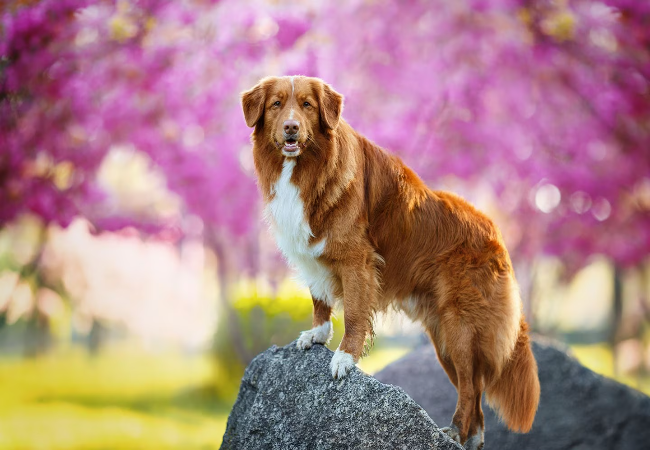Nova Scotia Duck Tolling Retriever 2025: Energetic Red Hunter 🐶

In this article
Nova Scotia Duck Tolling Retriever 2025: Energetic Red Hunter 🐶
By Dr. Duncan Houston BVSc
Introduction 🌟
The Nova Scotia Duck Tolling Retriever—also called the “Toller”—is the smallest of the retriever breeds, originating in Nova Scotia, Canada. Bred to lure waterfowl within gunshot range by playful antics (“tolling”), it is energetic, intelligent, affectionate, and a tireless swimmer. This 2025 guide covers its rich history, physical traits, exercise demands, grooming, health screenings, training tips, and ideal fit for modern homes.
1. Origins & History 📜
- Developed in early 19th century Yarmouth County, Nova Scotia—called “Little River Duck Dog” or “Yarmouth Toller”—to entice and retrieve ducks.
- Bred from a mix of retrievers, setters, spaniels, and farm collies to create a compact, agile gundog.
- Recognized by the Canadian Kennel Club in 1945, the AKC in 2003, and FCI in 1981.
- Named “little red dog” with fox-like coat and webbed feet to improve water work.
2. Size & Appearance 🧩
- Height: 17–21 in; Weight: 35–50 lb.
- Medium‑length double coat in golden‑red or copper with white markings on chest, paws, and tail-tip.
- Muscular, compact frame with webbed paws, fox-like expression, triangular ears, and wagging plumed tail.
3. Temperament & Personality ❤️
- Highly intelligent, affectionate, and eager to please—great with children and other pets.
- Alert and active; loves outdoor adventures, water, and play.
- Independent but friendly; reserved with strangers unless socialized.
- May produce a high-pitched “toller scream” when excited—typical of the breed.
4. Exercise & Mental Enrichment 🏃♂️
- High energy: needs at least 60–90 minutes of vigorous daily activity—swimming, fetch, agility, hiking.
- Enjoys structured activities: retrieving games, scent work, obedience, dock diving.
- Without stimulation, may become destructive—provide mental puzzles and social interaction.
5. Grooming & Coat Care ✂️
- Brush weekly to prevent mats; daily during shedding seasons.
- Bathe only as needed to maintain coat oils and water repellency.
- Routine care: trim nails, clean ears and teeth, remove dead fur.
6. Health & Lifespan 🩺
Lifespan: Typically 12–14 years, occasionally 10–14.
- Generally healthy; recommended screening for hips, eyes, thyroid, and autoimmune issues.
- Common concerns: hip dysplasia, progressive retinal atrophy (~7% affected), autoimmune thyroiditis, Addison’s disease (~1%).
- Immune-mediated conditions: meningitis-arthritis, eye disorders; breeders use genetic test panels.
7. Nutrition & Feeding 🍽️
- Feed high‑quality medium‑/large‑breed kibble; divide into 2 meals to reduce bloat risk.
- Monitor weight and adjust portions; fresh water available at all times.
- Discuss supplements with vet (omega‑3s, joint support) as needed for aging dogs.
8. Training & Socialization 🎓
- Highly trainable with positive reinforcement and playful methods.
- Begin socialization early—expose to varied people, animals, and noises.
- Consistency and routine are essential to channel energy and prevent boredom-driven behavior.
9. Family Fit & Living Situations 🏡
- Best for active families, hunters, or dog-sport enthusiasts—thrives with tasks.
- Great with children and other dogs; early exposure minimizes prey drive issues.
- Needs a secure yard or daily activity; not ideal for sedentary households.
- Apartment living is possible with committed exercise and mental enrichment.
10. Adoption & Breeder Advice 🌟
- Prefer breeders who test hips, eyes, thyroid, Addison’s, and PRA; ask for clearances.
- Expect puppy prices around $1,500–2,500 USD; rescues are rare but exist.
- Look for involvement with Toller clubs; health-screening programs are actively managed due to a small gene pool.
11. FAQs ❓
- Do they shed? Yes—moderate seasonal shedding; weekly brushing helps.
- Are they good with kids? Absolutely—loving and sociable, thrive in families.
- Do they bark a lot? Moderate—alert bark; the “toller scream” is rare but distinctive.
- Are they apartment-friendly? Can be—with enough exercise and engagement.
- How long do they live? Typically 12–14 years; good health care extends lifespan.
12. Ask A Vet, 🐶
- Ask A Vet: Guidance on health screening, autoimmune conditions, joint support, and diet planning.
13. Final Thoughts ✅
The Nova Scotia Duck Tolling Retriever is a vibrant, versatile, and affectionate companion—best suited for owners who can match its energy, intelligence, and love for the outdoors. With structured care, early training, and purpose-driven outlets, the Toller thrives. For ongoing expert support, visit AskAVet.com and download the Ask A Vet app for personalized guidance on raising your Little Red Duck Hunter!






